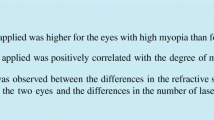Abstract
Laser indirect ophthalmoscope (LIO) photocoagulation and transscleral photocoagulation through the conjunctiva and subconjunctiva were performed in the fundus of chinchilla gray rabbits using various exposure times and powers, and the thresholds for retinal blanching and choroidal hemorrhage were determined. The therapeutic range was described for both applications as the ratio between energy values to produce grayish white lesions and hemorrhage at 50% probability. The therapeutic range appeared to remain almost constant with different exposure times. The mean ratio with LIO was 3.2±0.28, similar to that with slit-lamp delivery reported in our previous study. The mean ratio with transscleral photocoagulation through the conjunctiva and subconjunctiva were 2.48 ± 0.28 and 2.38 ± 0.26, respectively. The variability of LIO appeared to be a little lower than with transscleral photocoagulation. There was no significant difference between the variability with transscleral photocoagulation through the conjunctiva and subconjunctiva.
Similar content being viewed by others
References
Avery RL, Repka MX, Green WR, D'Anna S, Goldberg MF (1991) A comparative study of diode and argon laser indirect photocoagulation of primate retina. Invest Ophthalmol Vis Sci 15:1233 (ARVO abstract)
Benner JD, Husang M, Ishigooka H, Morse LS, Toth CA, Hjelmeland LM, Landers III MB (1991) A comparison of argon, krypton and diode binocular indirect ophthalmoscope laser photocoagulation in the rabbit. Invest Ophthalmol Vis Sci 15:1232 (ARVO abstract)
Birngruber R, Gabel V-P, Hillenkamp F (1977) Fundus reflectometry: a step towards optimization of the retina photocoagulation. Mod Probl Ophthalmol 18:383–390
Birngruber R, Hillenkamp F, Gabel V-P (1978) Experimentelle und theoretische Untersuchung zur thermischen Schädigung des Augenhintergrundes durch Laserstrahlung. GSF Bericht A0251, Gesellschaft für Strahlen- und Umweltforschung, München, Germany
Birngruber R, Hillenkamp F, Gabel V-P (1985) Theoretical investigation of laser thermal retinal injury. Health Physics 48:781–796
Boettner EA, Wolter JR (1962) Transmission of the ocular media. Invest Ophthalmol Vis Sci 1:776–783
Cryotherapy for Retinopathy of Prematurity Cooperative Group (1988) Multicenter trial of cryotherapy for retinopathy of prematurity. Preliminary results. Arch Ophthalmol 106:471–479
Cryotherapy for Retinopathy of Prematurity Cooperative Group (1988) Multicenter trial of cryotherapy for retinopathy of prematurity. Three-month outcome. Arch Ophthalmol 108:195–204
Cryotherapy for Retinopathy of Prematurity Cooperative Group (1988) Multicenter trial of cryotherapy for retinopathy of prematurity. One-year outcome — structure and function. Arch Ophthalmol 108:1408–1416
Duke-Elder (1963) System of ophthalmol, vol III, part 1. Henry Kimpton, London, pp 101, 273
Friberg TR (1990) Principles of photocoagulation using binocular indirect ophthalmoscope laser delivery systems. Int Ophthalmol Clinics 30:89–94
Gabel V-P, Birngruber R, Hillenkamp F (1976) Die Lichtabsorption am Augenhintergrund, GSF Bericht A55. Gesellschaft für Strahlen- und Umweltforschung, München, Germany
Gabel V-P, Birngruber R, Hillenkamp F (1978) Visible and near infrared light absorption in pigment epithelium and choroid. In: International Congress Series No. 450, XXIII Concilium Ophthalmol Kyoto, Excerpta Media/Elsevier, Amsterdam Oxford, pp 658–662
Geeracts WJ, Berry BS (1968) Ocular spectral characteristics as related to hazards from lasers and light sources. Am J Ophthalmol 66:15–20
Jaccoma E, Conway B, Campochiaro P (1980) Cryotherapy causes extensive breakdown of the blood-retinal barrier. Arch Ophthalmol 103:1728–1730
Jennings T, Fuller T, Vukick JA, Lam TT, Joondeph BC, Ticho B, Blair NP, Edward DP (1990) Transscleral contact retinal photocoagulation with an 810 nm semiconductor diode laser. Ophthalmic Surg 21:492–496
Litchfield JT Jr, Wilcoxon F (1949) A simplified method of evaluating dose-effect experiments. J Pharmacol Exp Ther 96:99–113
Lorenz B, Vogel A, Gabel V-P (1990) Time resolved histology after diode and argon laser coagulation in the rabbit fundus. In: Wilhelm Waidelich and Raphaela Waidelich (eds) Proceeding of 9th International Congress of Laser/Optoelectrics in Medicine. Springer, Berlin Heidelberg New York, pp 267–270
Mann IDA (1949) The development of the human eye. British Medical Association, London, pp 197–201
Micael LM, Rodriges MM, Fine BS (1972) Light and electron microscopic observations on the pigment layers of the developing human eyes. Am J Ophthalmol 73:167–182
Obana A, Lorenz B, Gaessler A, Birngruber R (1992) The therapeutic range of chorioretinal photocoagulation with diode and argon lasers: an experimental comparison. Lasers Light Ophthalmol 4:147–156
Okamoto S, Takahashi H, Fukado Y, Ozawa T (1990) Laser diode application for transscleral photocoagulation. Lasers Light Ophthalmol 3:29–37
Peyman GA, Conway MD, Raichand M, Lin J (1984) Histopathologic studies on transscleral argon-krypton photocoagulation with an exolaser probe. Ophthalmic Surg 15:496–501
Peyman GA, Naguid KS, Gaasterland D (1990) Transscleral application of a semiconductor diode laser. Lasers Surg Med 10:569–575
Rol P, Niederer P, Duerr U, Henchoz P-D, Fankhauser F (1990) Experimental investigation on the light scattering properties of the human sclera. Lasers Light Ophthalmol 3:201–212
Tso MOM, Wallow IHL, Elgin S (1977) Experimental photocoagulation of the human retina. I. Correlation of physical, clinical and pathological data. Arch Ophthalmol 95:1035–1040
Vogel A, Dlugos C, Nuffer R, Birngruber R (1991) Optical properties of human sclera and their consequences of transscleral laser applications. Lasers Surg Med 11:311–340
Author information
Authors and Affiliations
Rights and permissions
About this article
Cite this article
Obana, A., Lorenz, B. & Birngruber, R. Transscleral and indirect ophthalmoscope diode laser retinal photocoagulation : Experimental quantification of the therapeutic range for their application in the treatment of retinopathy of prematurity. Graefe's Arch Clin Exp Ophthalmol 231, 378–383 (1993). https://doi.org/10.1007/BF00919644
Received:
Accepted:
Issue Date:
DOI: https://doi.org/10.1007/BF00919644




